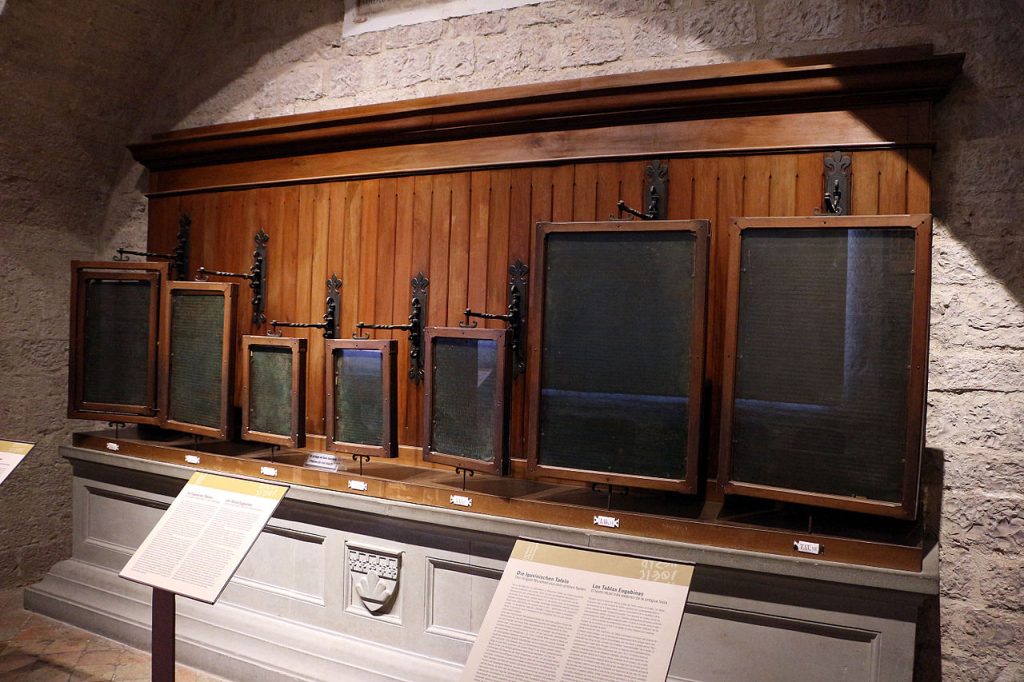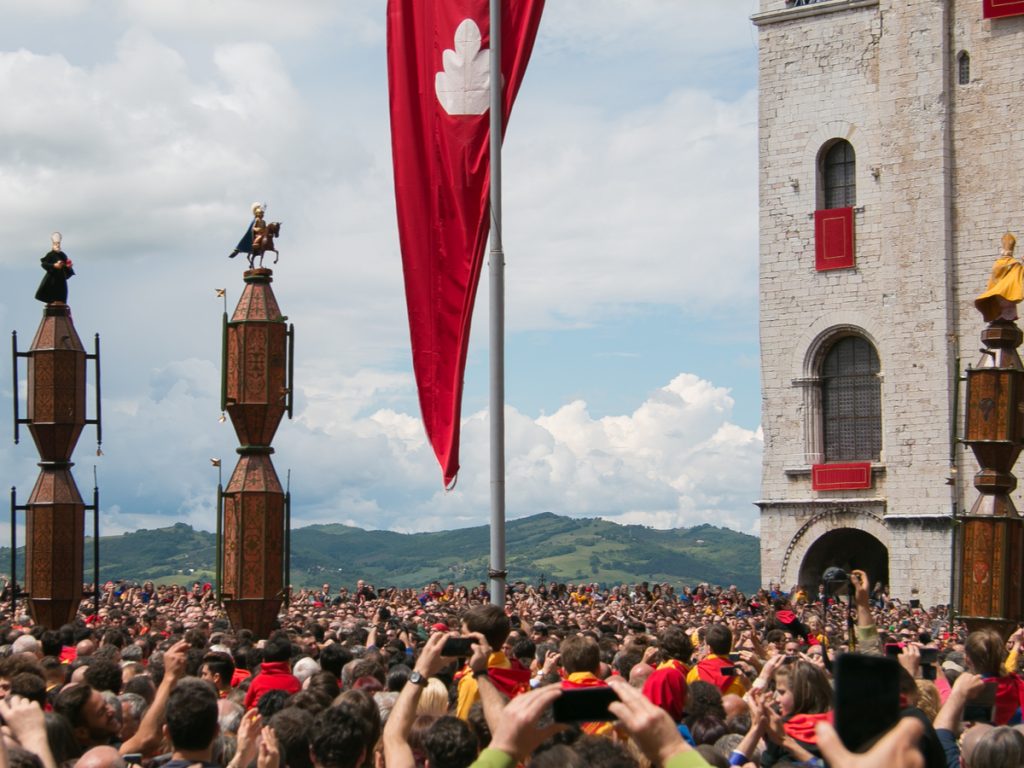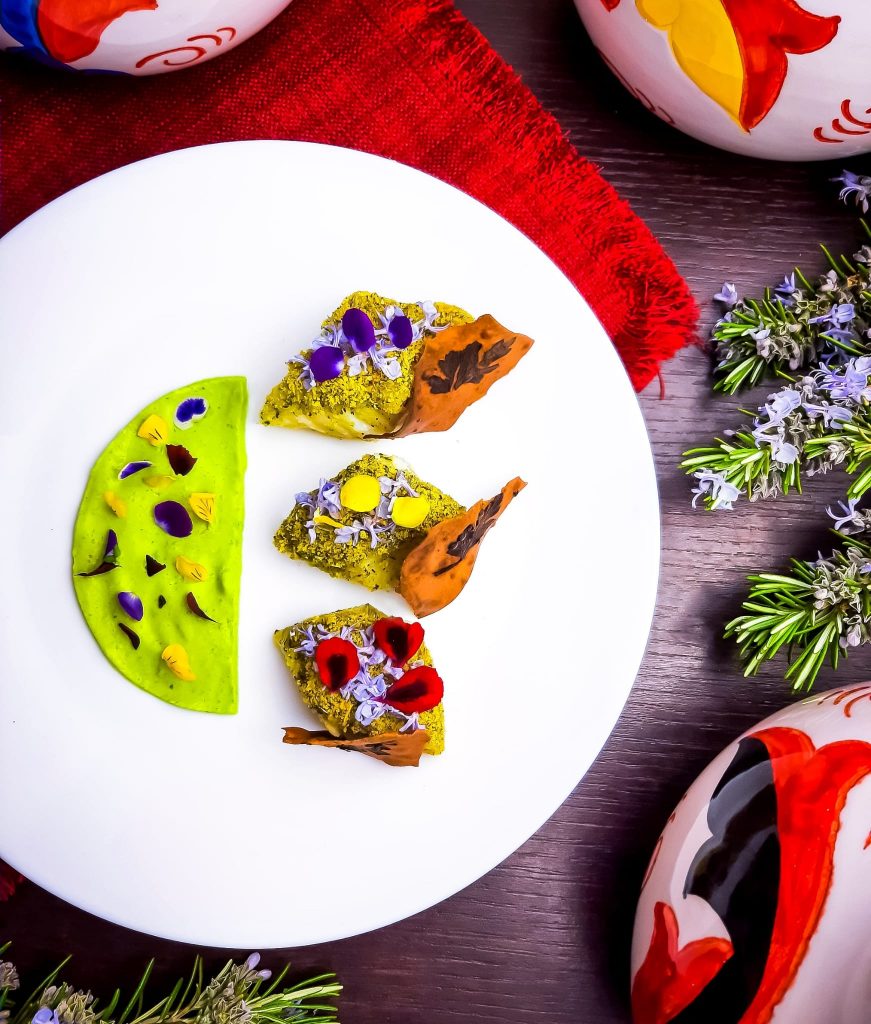Festa dei Ceri, Gubbio
Ci sono ricette che non sono semplicemente dei piatti tradizionali. Il baccalà alla ceraiola è molto di più: Un rituale mistico, che conserva nei suoi sapori le emozioni di un popolo che custodisce in esso memorie intime e pagine di vita. Siamo a Gubbio, in Umbria, città di pietra cinta di mura medievali che la proteggono dai consueti ordini cronologici. Qui passato e presente passeggiano in armonia per le strette vie del centro in un mondo sospeso dal tempo e dal rumore della modernità, dove gli abitanti non vivono di rievocazioni e storiche eredità, ma sono l’estensione vitale delle fondamenta della città. Città del silenzio Gubbio, parlano per lei le sue tavole bronzee, testimoni di un popolo più antico degli Etruschi che conserva geloso le sue ceramiche, i mosaici e l’urbanistica di un passato glorioso che va dai romani, ai Montefeltro. Un luogo magico, dove l’artigianato non è un lavoro ma un mestiere e questo mestiere è arte.
La città dei matti

Gubbio citata da Dante nella Divina Commedia, amata da San Francesco, che quì ammansì il famoso lupo; La città dei matti è chiamata, forse per la presenza di iridio, o più semplicemente per il carattere eccentrico, stravagante e coraggioso degli Eugubini, capaci di suonare ancora a mano una campana da 20 quintali, che è del maestoso Palazzo dei Consoli, sospesi a oltre 60 metri di altezza. La voce della città, che arriva fino alle remote campagne del comune scandendo tempi e ricorrenze millenarie, Festa dei Ceri in primis, che si svolge il 15 maggio ma per certi versi vissuta e sentita tutto l’anno, tra le più antiche, se non in assoluto la più remota manifestazione folcloristica italiana.
La Festa dei Ceri

La Festa dei Ceri è un concentrato di passione, gioia, adrenalina e devozione, un incantesimo che risveglia gli Eugubini dal torpore autunnale richiamandoli ad un evento viscerale e ad un sentimento che scorre nelle vene di ogni cittadino fin dalla nascita. I Ceri sono tre alti e pesanti manufatti lignei sormontati rispettivamente dalle statue di S. Ubaldo (protettore dei Muratori), di S. Giorgio (protettore dei Merciai) e di S. Antonio Abate (protettore degli Asinari e dei Contadini, che vengono portate a spalla e di corsa per le vie della città fino alla Basilica di Sant’Ubaldo, in vetta al monte Ingino. Un’ ascesa che sa di religiosa fatica, di condivisione e liberazione, di gioioso quanto tribolato omaggio comune al patrono: S.Ubaldo. Fu vescovo di Gubbio nel 12° secolo, e da sempre si preoccupò del benessere spirituale dei suoi concittadini, un’ infaticabile mediatore, e pacificatore delle violente lotte intestine e strenuo difensore della sua città dagli attacchi dei comuni limitrofi o dalla minaccia di Federico Barbarossa; Per tali motivi è stato ed è ancora così amato, un punto di riferimento costante per ogni Eugubino del passato e del presente.
Baccalà alla Ceraiola
Veniamo quindi al Baccalà alla Ceraiola, ma non potevo parlarvene senza le dovute premesse; Viene preparato, come intuibile, in occasione della Festa dei Ceri in onore proprio a S. Ubaldo. La sua preparazione è affidata all’Università dei Muratori, erede dell’antica corporazione medievale dei maestri delle pietre, “i Petraioli” che da sempre si occupano di organizzare la solenne manifestazione e di cucinare il baccalà per tutti i “ceraioli”. Ne vengono preparati circa 15 quintali, per quasi 10mila vaschette, è un rito antico, un momento consueto che alla vigilia della grande Festa, precede le emozioni e l’entusiasmo dell’indomani.
Una ricetta tipica e segretissima, mai stata scritta, tesoro culinario tramandato esclusivamente a voce tra i soli uomini dell’università, nessun’altro la conosce, ragion per cui la mia versione di questo piatto non potrà mai essere come l’originale ma ho cercato di prepararla nella maniera più fedele possibile perchè in fondo di fede parla questo piatto, scelto probabilmente perchè un tempo il pesce era considerato un piatto povero ma che oggi diviene un cibo prelibato, semplice e con l’anima della festa, ed io l’ho immaginato così, proprio come la mia festa: Ricco di colori, di geometrie e dei profumi di maggio, come una piazza di primavera colma di gente. L’ho preparato con la devozione che merita e anche con tanta responsabilità, che inevitabilmente si sente quando racconti qualcosa che ami indissolubilmente.

Baccalà alla Ceraiola
Ingredienti:
- 800 gr baccalà già ammollato
- Pangrattato q.b.
- Rametti di rosmarino fresco
- Sale q.b.
- Pepe q.b.
- Olio extravergine di oliva
- Vino bianco q.b.
Procedimento:
Accendete il forno a 180°, tritate finemente gli aghi del rosmarino e Mescolateli con il pangrattato, il sale e il pepe. Ora tagliate i filetti di baccalà a piccoli tranci, passateli da ogni lato nel pangrattato aromatizzato al rosmarino, quindi trasferiteli in una teglia ben oleata. Ora aggiugete altro pangrattato sui tranci e ancora un filo d’olio e un pò di vino bianco sul fondo della teglia. Infornate a 180°C in forno già caldo per 30-35 minuti.
Baccalà alla Ceraiola (Dried Cod Ceraiola)
Some recipes are not simply traditional dishes. The Baccalà alla Ceraiola is much more: it’s a mystical ritual that preserves in its flavors the intimate memories and experiences of a population. We are in Gubbio, Umbria, a stone city surrounded by medieval walls. Here, past and present walk in harmony through the narrow streets of the city center in a world suspended in time and far from the noise of modernity. Inhabitants here do not live on re-enactments and historical legacies, but are the vital extension of the foundations of the city. Gubbio is the city of silence: its bronze tablets (Tavole di Gubbio, also called Tavole Eugubine) speak for it, witnesses of a civilization older than the Etruscans whose jealously preserve its ceramics, mosaics and urban planning of a glorious past that goes from the Romans to the Montefeltro. A magical place, where craftsmanship is not a job as much as an art.
The City of Madmen
Gubbio, mentioned by Dante in the “Divine Comedy” and loved by San Francesco who here tamed the famous wolf, is called the City of Madmen. Perhaps for the presence of Iridium or more simply, for the eccentric, extravagant and courageous character of the Eugubinis–still able to play a 20 quintal bell by hand suspended 60 meters high in the majestic Palazzo dei Consoli. That bell is the voice of the city that reaches the remote countryside of the municipality. It marks times and millennial anniversaries and primarily, the Festa dei Ceri which takes place on May 15th. It is one of the oldest, if not the most remote, Italian folklore event.
The Festa dei Ceri
The Festa dei Ceri is the quintessence of passion, joy, adrenaline and devotion. A spell that awakens the Eugubini from the autumn torpor, recalling them to a visceral event and stirring up a feeling that flows in the veins of every citizen from birth. The Ceri are three tall and heavy wooden artifacts surmounted respectively by the statues of St. Ubaldo (protector of the Masons); St. Giorgio (protector of the Haberdashers); and of St. Antonio Abate (protector of the Breeders and of the Peasants). All are carried on mens’ shoulders through the city streets to the Basilica of St. Ubaldo they reach the top of Mount Ingino.
It is an ascent that strikes of religious toil; sharing and liberation; and joyful and troubled homage to the patron saint, St. Ubaldo. He was the Bishop of Gubbio in the 12th century and was always concerned about the spiritual well-being of his fellow citizens. Furthermore, St. Ubaldo was an indefatigable mediator and peacemaker of violent internal strife and a staunch defender of his city from the attacks of neighboring municipalities or from the threat of Frederick Barbarossa. For these reasons, he has been and still is very much loved and a constant point of reference for every Eugubin.
Baccalà alla Ceraiola
So let’s continue to Baccalà alla Ceraiola… I couldn’t tell you about it without the necessary principles! As you can guess, the dish is prepared on the occasion of the Festa dei Ceri in honor of St. Ubaldo. Its preparation is entrusted to the University of Masons, heir to the ancient medieval corporation of stone masters, the Petraioli who have always been involved in organizing the solemn event and cooking the cod for all the ‘ceraioli’. About 1.500 kilograms are prepared, for almost 10 thousand containers. It is an ancient rite, a customary moment on the eve of the great festival that precedes the emotions and enthusiasm of the following day.
A typical and very secret recipe that has never been written. This culinary treasure has been handed down exclusively by word of mouth among only the men of the university. No one else knows it which is why my version of this dish will never be like the original. I tried to prepare it as faithfully as possible because basically this dish speaks of faith.
Fish was once a poor dish, but today becomes a delicacy, simple and with the feast’s soul in it. And that’s how I imagined it my feast: rich in colors, geometrics and scents of May like a spring square full of people. I prepared it with the devotion it deserves and also with the responsibility which you inevitably feel when you express something that you love indivisibly.
Baccalà alla Ceraiola
Ingredients:
- 800 gr of dried cod already soaked
- Breadcrumbs
- Sprigs of fresh rosemary
- Salt as needed
- Pepper as needed
- Extra virgin olive oil
- White wine as needed
Method:
Preheat the oven to 180°, finely chop the rosemary and mix it with the breadcrumbs, salt and pepper. Now cut the cod fillets into small slices, pass them on each side in the breadcrumbs flavored with rosemary, then transfer them to a well-oiled pan. Now add more breadcrumbs on the slices, a little more oil and a little white wine on the bottom of the pan. Bake at 180° C in a preheated oven for 30-35 minutes.


